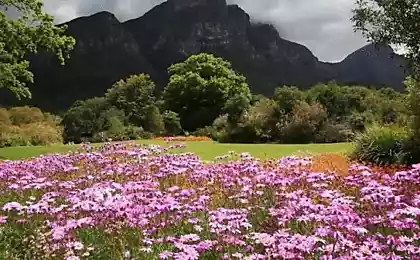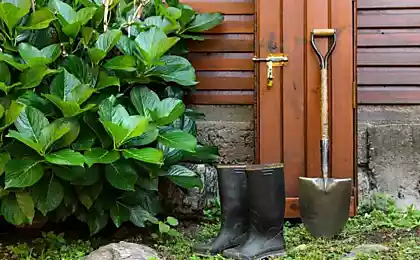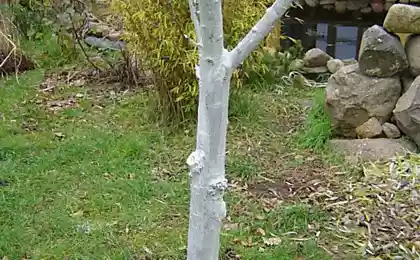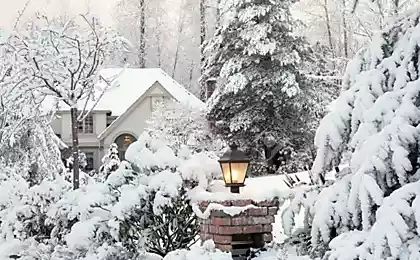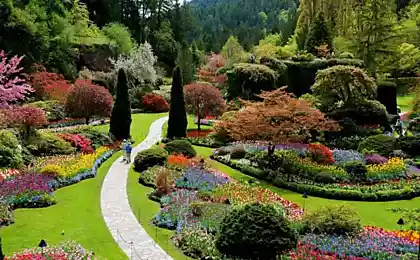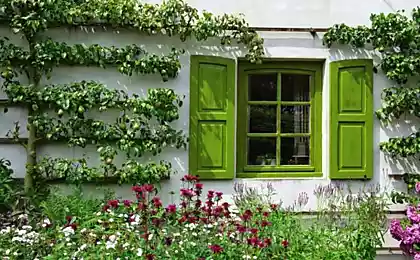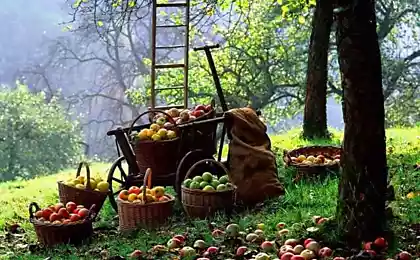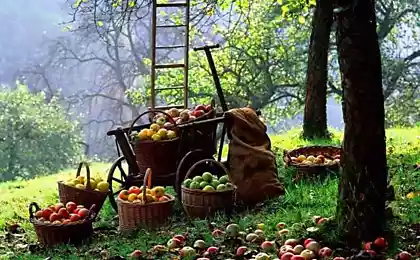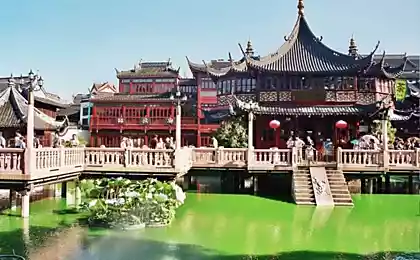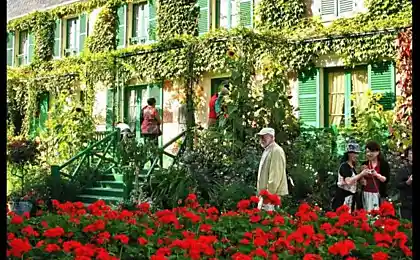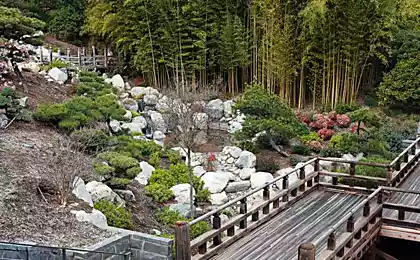522
Whitewashing of trees — when, how and whether at all
The whitewashed trees in our country have long been a symbol throughout the spring cleanup. According to tradition, after all joint harvesting are carried buckets of lime. The white trunk trees, and at the same time came to the attention of the poles as a sign: the mission of the labour troops is made. It is not surprising that many believe whitewash trees purely decorative act and treat it accordingly. And in fact, it is extremely important in the life of the tree.

Do I have to whitewash the trees?To understand the meaning of whitewash, it is necessary to say a few words on the bark of a tree, which, in fact, and chemic. Bark for wood — like skin for humans: protecting internal organs, she first meets all of the unfavorable external environment. And they are many: sharp fluctuations of temperatures, biting wind, sun and extreme cold, the teeth of rodents, the action of pests, and of the people themselves with their habit to light a fire under the tree and cut on the bark of their immortal name or a message "John + Kate = love". Cora gets sunburn and frostbite, coarse and cracked, sore and peeling. Who among us has not seen the difference between the smooth skin of the young seedling and rough cracked bark of the old? But the consequences of trauma to the skin, too, know all — to the disease in the organism to penetrate the infections and pests that weaken him, lead to premature wilting and death.
Therefore, the bark of the tree you want to protect. Here for this is whitewashing, it is:
protects tree bark from burns — winter and early spring, when foliage which serves as protection from the sun, for natural reasons, there is simply no;
protects from temperature changes, and hence prevents cracking of the crust (the appearance of morozovoy);
helps to protect against insect pests, whose larvae dwell in the bark.
So refer to the whitewashing of trees as a purely decorative event — error. Many years of experience gardeners is clear: it is an effective protective measure for the crust.

Blanching is necessary as Mature trees and young. Many gardeners are convinced that the young trees to whitewash, because the plaster can burn tender bark. Besides, clasping the stem, it prevents its growth (thickening). Is it really so?
The problem, as always, has two sides. Without a doubt, the high concentration of lime will damage young bark, but this can be avoided. Reduce by half the lime content, use latex or acrylic paint or, in the end, silver biomasei. But if not blanching, then sunburn and monotony will cause a young sapling harm immeasurably greater than the possible harm from lime.
For example take a look at the seedlings that were grown in the nursery. Most often, they live there in cramped quarters and not get a light quenching. And when we plant this tree in your garden, it falls on the open space and easily gets sunburn of the bark. Therefore, young trees whitewashing is a must, especially in the autumn planting.
When blanching
Experienced gardeners recommend to whitewash the trees in the garden two or three times a year:
the main painting is considered autumn, it is held in October-November;
the spring and re-updating; it is held in late February-early March;
the third will be appropriate in the middle of summer.
The most effective whitewash, held in autumn, in October-November. Performed during the spring garden works, as a rule, already "late".
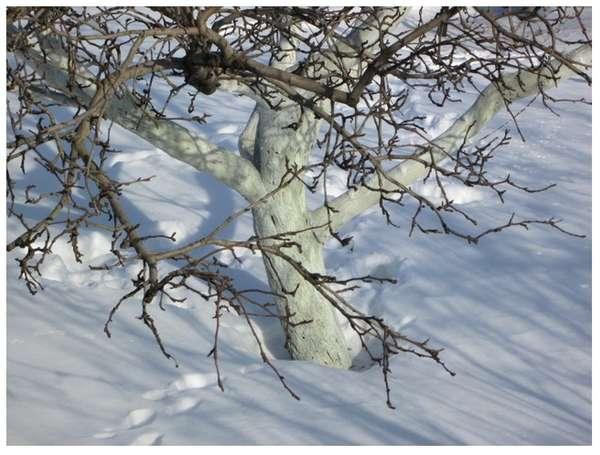
The most dangerous of all to wood is the Sunny days of February and cold March. Day unbleached brown trunk under the February sun warms up to +9...+11ºС — this temperature is enough to the tree woke up and started SAP flow. And night temperatures down to-10 ° C elementary freeze "tight" juice. The result is a breakdown of monotony that look like long cracks on the bark.
The color white repels sun rays and does not allow the barrel to heat up to a temperature of awakening. With whitewashed wood and spring "Wake up" a little later on, that may protect it from spring frosts to bloom it will start after them.
If autumn whitewash could not be held in February need to catch up as soon as the temperature will allow. It is not necessary to wait for the traditional April "Lenin's subbotnik" — then this procedure would actually be purely decorative. But if autumn whitewash went according to plan, the spring update can be done in February and March and even early April — when you cut time.
The third whitewash carry out not necessarily, especially if the trees are whitewashed persistent compounds, which makes it stay on for up to a year. But is it desirable, if pobelochnye layer washed away by rain or peeled.
How to whitewash trees
The most common question — what height whitewash — experienced gardeners say:
the entire trunk (the trunk from the root collar to the first skeletal branches of the lower tiers)
plus the lower boughs 1/3 of their length (many are even 1/2 of the length of branches whiten).
As they say, to defend, to protect! By and large, in such svetootdachu shell it would be good to clothe the entire tree, but this is time-consuming and expensive. Although such examples are not uncommon)
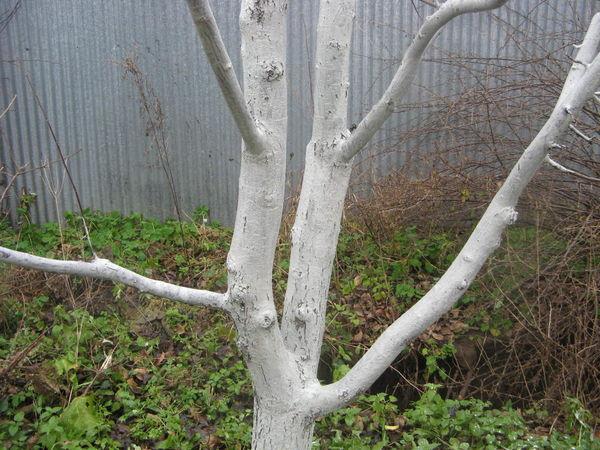
Bleached trees a variety of mortars: lime mortar, water-based and water-dispersion paint. Importantly, the surface of the trunk was white to pobelochnye composition allows the bark to "breathe" and not washed off as long as possible. To this basic mix add nutrients that support the adhesion of mortar to the barrel (this can be clay, milk, vegetable or green soap, casein glue or PVA glue).
In the next video, experienced gardener, Vyacheslav Fetisov shares his recipe for snow white and resistant whitewash that protects the bark of the tree throughout the year.
It remains to add that whitewash the trees in dry weather, the plaster has dried well and stuck in a new place. And be sure to do the job thoroughly, no gaps. A lot of interesting about the whitewashing you will be able to learn from reading the article secrets of the old gardener about the whitewashing of trees
And this is for you to smile. It is clear that from sunburn this coloring "the mix" not really protect you... But it looks positive)
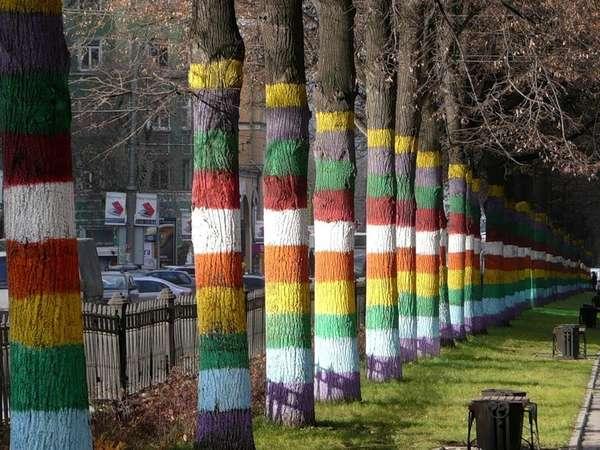
Now autumn, and it is about time the traditional doubts: "to Bleach or not to bleach that is the question." And this is the rare case when the question has a simple answer: blanching is a must! And right in the near future. Then, in a wonderful Sunny February day you praise yourself for something that your pet will not have the frosty night to suffer a long painful morozovoy.
Source: www.7dach.ru

Do I have to whitewash the trees?To understand the meaning of whitewash, it is necessary to say a few words on the bark of a tree, which, in fact, and chemic. Bark for wood — like skin for humans: protecting internal organs, she first meets all of the unfavorable external environment. And they are many: sharp fluctuations of temperatures, biting wind, sun and extreme cold, the teeth of rodents, the action of pests, and of the people themselves with their habit to light a fire under the tree and cut on the bark of their immortal name or a message "John + Kate = love". Cora gets sunburn and frostbite, coarse and cracked, sore and peeling. Who among us has not seen the difference between the smooth skin of the young seedling and rough cracked bark of the old? But the consequences of trauma to the skin, too, know all — to the disease in the organism to penetrate the infections and pests that weaken him, lead to premature wilting and death.
Therefore, the bark of the tree you want to protect. Here for this is whitewashing, it is:
protects tree bark from burns — winter and early spring, when foliage which serves as protection from the sun, for natural reasons, there is simply no;
protects from temperature changes, and hence prevents cracking of the crust (the appearance of morozovoy);
helps to protect against insect pests, whose larvae dwell in the bark.
So refer to the whitewashing of trees as a purely decorative event — error. Many years of experience gardeners is clear: it is an effective protective measure for the crust.

Blanching is necessary as Mature trees and young. Many gardeners are convinced that the young trees to whitewash, because the plaster can burn tender bark. Besides, clasping the stem, it prevents its growth (thickening). Is it really so?
The problem, as always, has two sides. Without a doubt, the high concentration of lime will damage young bark, but this can be avoided. Reduce by half the lime content, use latex or acrylic paint or, in the end, silver biomasei. But if not blanching, then sunburn and monotony will cause a young sapling harm immeasurably greater than the possible harm from lime.
For example take a look at the seedlings that were grown in the nursery. Most often, they live there in cramped quarters and not get a light quenching. And when we plant this tree in your garden, it falls on the open space and easily gets sunburn of the bark. Therefore, young trees whitewashing is a must, especially in the autumn planting.
When blanching
Experienced gardeners recommend to whitewash the trees in the garden two or three times a year:
the main painting is considered autumn, it is held in October-November;
the spring and re-updating; it is held in late February-early March;
the third will be appropriate in the middle of summer.
The most effective whitewash, held in autumn, in October-November. Performed during the spring garden works, as a rule, already "late".

The most dangerous of all to wood is the Sunny days of February and cold March. Day unbleached brown trunk under the February sun warms up to +9...+11ºС — this temperature is enough to the tree woke up and started SAP flow. And night temperatures down to-10 ° C elementary freeze "tight" juice. The result is a breakdown of monotony that look like long cracks on the bark.
The color white repels sun rays and does not allow the barrel to heat up to a temperature of awakening. With whitewashed wood and spring "Wake up" a little later on, that may protect it from spring frosts to bloom it will start after them.
If autumn whitewash could not be held in February need to catch up as soon as the temperature will allow. It is not necessary to wait for the traditional April "Lenin's subbotnik" — then this procedure would actually be purely decorative. But if autumn whitewash went according to plan, the spring update can be done in February and March and even early April — when you cut time.
The third whitewash carry out not necessarily, especially if the trees are whitewashed persistent compounds, which makes it stay on for up to a year. But is it desirable, if pobelochnye layer washed away by rain or peeled.
How to whitewash trees
The most common question — what height whitewash — experienced gardeners say:
the entire trunk (the trunk from the root collar to the first skeletal branches of the lower tiers)
plus the lower boughs 1/3 of their length (many are even 1/2 of the length of branches whiten).
As they say, to defend, to protect! By and large, in such svetootdachu shell it would be good to clothe the entire tree, but this is time-consuming and expensive. Although such examples are not uncommon)

Bleached trees a variety of mortars: lime mortar, water-based and water-dispersion paint. Importantly, the surface of the trunk was white to pobelochnye composition allows the bark to "breathe" and not washed off as long as possible. To this basic mix add nutrients that support the adhesion of mortar to the barrel (this can be clay, milk, vegetable or green soap, casein glue or PVA glue).
In the next video, experienced gardener, Vyacheslav Fetisov shares his recipe for snow white and resistant whitewash that protects the bark of the tree throughout the year.
It remains to add that whitewash the trees in dry weather, the plaster has dried well and stuck in a new place. And be sure to do the job thoroughly, no gaps. A lot of interesting about the whitewashing you will be able to learn from reading the article secrets of the old gardener about the whitewashing of trees
And this is for you to smile. It is clear that from sunburn this coloring "the mix" not really protect you... But it looks positive)

Now autumn, and it is about time the traditional doubts: "to Bleach or not to bleach that is the question." And this is the rare case when the question has a simple answer: blanching is a must! And right in the near future. Then, in a wonderful Sunny February day you praise yourself for something that your pet will not have the frosty night to suffer a long painful morozovoy.
Source: www.7dach.ru

